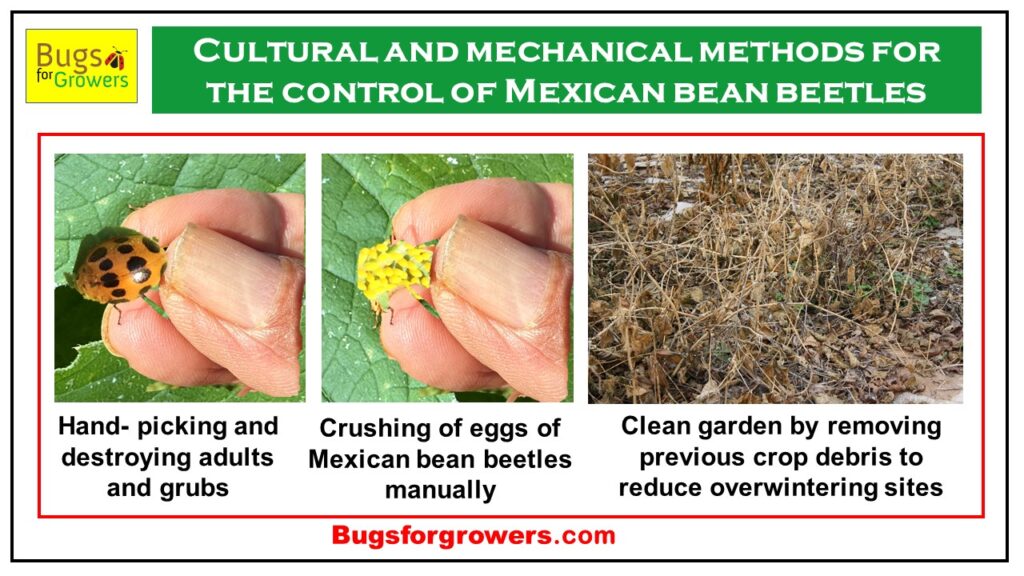Watch YouTube video on Biological and Cultural Control of the Mexican Bean Beetles
What are the Mexican Bean beetles?
The Mexican bean beetles (Epilachna varivestis) are one of the most damaging insect pests of many crops like black-eyed beans, french beans, lima beans, mung beans, snap beans, soybeans, velvet beans, beets, peas, pumpkins, squash, and tomatoes. This guide covers how to identify these beetles, and use biological and cultural control strategies for their management in organic gardens.
How can you distinguish Mexican bean beetles from lady beetles?
Both Mexican bean beetles and lady beetles look similar, but they differ morphologically and in their feeding habits. Adult Mexican bean beetles are orange, while lady beetles are red. Mexican bean beetles primarily feed on plants, whereas lady beetles feed on insect pests.
Identification of Mexican Bean Beetles
Correct identification of Mexican bean beetles early in the season is key to managing their infestations and reducing the damage caused by them. These beetles develop through four developmental stages including adult, egg, larva and pupa.
Adults: Oval-shaped and about 7 mm long, the adult beetles are orange with eight distinct black spots on each forewing. They have chewing and biting types of mouthparts.
Eggs: Yellow and tiny about 7 mm long. They are often laid in clusters on the undersides of leaves.
Larvae/Grubs: Mature larvae are yellow in color and approximately 9 mm long, with distinct branched dark yellow spines covering their bodies.
Pupae: Yellow, spineless, and about 7 mm long.

The Life Cycle of Mexican Bean Beetle
The life cycle of the mexican bean beetle begins when these beetles start emerging from their overwintering sites like previous crop debris or nearby bushes in spring and start mating. Mated females then lay clusters of 60-70 yellow colored eggs on the lower sides of leaves. Eggs hatch within 1-2 weeks into yellow larvae, which develop through four stages over the following 2- 3 weeks. Then mature larvae pupate on the undersides of leaves. New adults will emerge from pupae within a week, reproduce and the life cycle begins again. Thus the Mexican bean beetles can complete their life cycle within 4-6 weeks and 2- 3 generations in a year depending upon the temperature.
Damage Caused by Mexican Bean Beetle
Both grubs and adults damage plants by scraping away leaf tissue in irregular patches with their chewing mouthparts, leaving the veins intact. This results in a skeletonized appearance on heavily infested leaves. Both stages primarily feed on the undersides of leaves, causing them to turn brown and eventually die. During peak populations, from early July to late August, they may also damage pods and flowers, significantly reducing crop yields.
Effective Strategies for Controlling Mexican Bean Beetles
Managing Mexican bean beetles with cultural and biological control methods can minimize their populations and protect crops without heavy reliance on chemical pesticides. Use of chemical pesticides in organic gardens for controlling mexican beetles or other insect pests is avoided due to their detrimental effects on human health and the environment.
Cultural Control
- Hand-Picking: Regularly check for adults and larvae and remove them manually and destroy them.
- Egg Crushing: Crushing egg masses with your thumb and index finger prevents larvae from hatching and damage caused by them.
- Garden Cleanup: Remove plant debris at the end of the growing season to eliminate overwintering sites for adult beetles.
Biological Control
Several natural enemies are effective against Mexican bean beetles and can be introduced into your garden for added pest control:
- Spined Soldier Bug (Podisus maculiventris): A beneficial predatory insect, the spined soldier bug preys on Mexican bean beetle larvae and can significantly reduce their populations.
- Parasitic Wasp (Pediobius foveolatus): This parasitic wasp targets the beetle’s larvae and pupae, killing them and preventing the beetles from maturing into adults. These wasps are commercially available and can be released into affected areas.
Conclusion
Combining cultural and biological control strategies can help growers reduce the damage caused by Mexican bean beetles.








